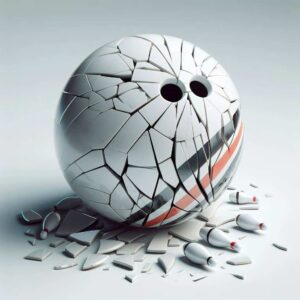Bowling is a beloved pastime enjoyed by millions worldwide, often seen as a leisurely activity for families and friends to gather and have fun. However, many overlook the fact that bowling can be an incredibly challenging sport that demands a unique blend of physical skills, mental fortitude, and strategic thinking.
While the basic premise of rolling a ball towards pins may seem simple, excelling in competitive bowling requires mastering a complex set of techniques and abilities that separate the casual bowler from the elite.
In this comprehensive guide, we’ll explore the various aspects that make bowling a surprisingly difficult sport, one that deserves recognition for the challenges it presents at the highest levels.
From the physical demands on the body to the intricate strategies involved, we’ll shed light on why bowling should be considered a legitimate and demanding athletic pursuit.
The Physical Demands of Bowling
-
Repetitive Arm Motion and Injury Risks
Contrary to popular belief, bowling can be quite taxing on the body, particularly due to the repetitive motion involved in the delivery of the ball. Professional bowlers can roll hundreds of balls during a single tournament, placing immense stress on their shoulders, elbows, and wrists. This repetitive strain can lead to various injuries, including tendinitis, bursitis, and even stress fractures.
To mitigate these risks, elite bowlers often undergo rigorous training regimens to strengthen their muscles, improve flexibility, and develop proper technique. Many also work with physical therapists and trainers to ensure they’re using the correct form and minimizing the risk of injury.
-
Core Strength and Balance Required
While the focus is often on the arm swing, bowling also demands significant core strength and balance. A strong core is essential for maintaining proper body positioning throughout the approach and delivery, allowing for a smooth and consistent release. Without adequate core strength, bowlers may struggle to maintain their form, resulting in inconsistent shots and potential injuries.
Additionally, the act of rolling a heavy bowling ball while maintaining balance on a slippery surface requires exceptional proprioception and stability. Even a slight misstep or imbalance can throw off the entire delivery, leading to errant shots and frustration.
-
Endurance for Long Tournaments
At the professional level, bowling tournaments can span multiple days, with bowlers playing numerous games or matches in succession. This endurance test requires not only physical stamina but also mental fortitude to maintain focus and consistency throughout extended periods of play.
Professional bowlers often undergo rigorous conditioning programs to build endurance, combining cardiovascular exercises with strength training to ensure they can perform at their best even after hours of intense competition.
-
Examples of Professional Bowlers’ Training Regimens
To illustrate the level of dedication required, consider the training routines of some of the world’s top bowlers:
- Jason Belmonte, a two-handed bowling phenomenon, incorporates strength training, yoga, and specialized drills to maintain his unique technique and prevent injuries.
- Walter Ray Williams Jr., a Hall of Famer with numerous major titles, emphasizes core strengthening exercises and uses resistance bands to improve his flexibility and arm strength.
- Kelly Kulick, one of the most successful female bowlers, follows a rigorous workout plan that includes weight training, cardio, and specialized exercises to target the muscles used in bowling.
The Mental Challenges of Bowling
-
Focus and Concentration
While the physical demands of bowling are significant, the mental challenges can be equally daunting. Maintaining focus and concentration throughout an entire game, let alone a multi-day tournament, is a formidable task.
In a sport where even the slightest lapse in attention can result in a missed strike or a costly error, bowlers must cultivate an unwavering ability to stay present and block out distractions.
This mental fortitude separates the elite from the average, as the pressure and intensity of competitive bowling can be overwhelming for those unprepared.
-
Reading Lane Conditions and Making Adjustments
One of the most challenging aspects of competitive bowling is the ability to read and adapt to constantly changing lane conditions. Factors such as oil patterns, humidity, and ball wear can significantly impact the way a ball reacts on the lane, requiring bowlers to make split-second adjustments to their delivery, ball selection, and targeting.
Elite bowlers spend countless hours studying lane patterns, ball dynamics, and oil patterns to develop an intuitive understanding of how to adjust their approach based on the conditions. This skill takes years of experience and a deep knowledge of the sport, making it a significant barrier to entry for those looking to excel at the highest levels.
-
Dealing with Pressure in Competitive Settings
In addition to maintaining focus and adapting to changing conditions, competitive bowlers must also learn to manage the intense pressure that comes with high-stakes tournaments and matches.
The ability to perform under the scrutiny of spectators, cameras, and opponents can be a daunting challenge, even for the most seasoned professionals.
Developing mental toughness and resilience is crucial for success in bowling, as a single missed shot or poor game can have significant consequences in a tournament format.
Top bowlers often work with sports psychologists and employ mental training techniques to help them stay calm, composed, and confident in high-pressure situations.
-
Mental Toughness and Resilience
Closely tied to dealing with pressure is the need for mental toughness and resilience in bowling. The sport can be incredibly unforgiving, with small mistakes often leading to disastrous consequences, such as a split or a missed spare.
Elite bowlers must possess the ability to bounce back from setbacks, maintain their composure, and continue executing at a high level regardless of the circumstances.
This mental fortitude is a rare and valuable trait that separates the truly great bowlers from those who struggle to maintain consistency in the face of adversity.
The Strategy and Technique of Bowling
-
Understanding Ball Dynamics and Rotation
While the act of rolling a ball towards pins may seem straightforward, the mechanics and dynamics involved are far more complex than they appear.
At the highest levels of competitive bowling, understanding the intricacies of ball rotation, revolutions per minute (RPM), and the physics behind the ball’s motion is essential for success.
Elite bowlers spend countless hours studying and analyzing ball dynamics, experimenting with different weights, coverstock materials, and layouts to achieve the desired motion and reaction on the lanes.
This deep understanding of ball behavior allows them to make informed decisions about equipment selection and adjustments based on the conditions they face.
-
Lane Play and Targeting
Another critical aspect of bowling strategy is lane play and targeting. Bowlers must develop a keen understanding of how to approach different lane patterns, where to target their shots, and how to adjust their line based on the ball’s reaction.
Advanced lane play techniques, such as playing the outside line or utilizing the track area, can be the difference between a strike and an open frame. Top bowlers employ these strategies to navigate challenging conditions and maximize their scoring potential.
-
Selecting the Right Equipment and Ball Drilling
In addition to understanding ball dynamics and lane play, selecting the right equipment and having balls properly drilled can significantly impact a bowler’s performance. Factors such as weight, coverstock material, core design, and layout all play a role in how a ball will react on the lanes.
Elite bowlers often work closely with pro shop operators and ball manufacturers to ensure their equipment is optimized for their individual styles and the specific conditions they face. This attention to detail and customization is a hallmark of top-level competitive bowling and contributes to the sport’s complexity.
-
Advanced Techniques (e.g., Curve, Spin, etc.)
At the highest levels of competition, bowlers employ a variety of advanced techniques to gain an edge and maximize their scoring potential. These techniques can include imparting curve or spin on the ball, using specialized release styles (such as two-handed or thumbless), or employing intricate footwork and timing adjustments.
Mastering these advanced techniques requires years of dedicated practice and a deep understanding of the sport’s nuances. It’s a testament to the skill and athleticism required in bowling, as these techniques are often extremely difficult to execute consistently and can be the difference between a strike and a split.
The Competitive Landscape of Bowling
-
Professional Bowling Associations and Tours
Contrary to the perception that bowling is merely a recreational activity, there exists a thriving professional competitive scene with numerous associations and tours dedicated to the sport.
Organizations such as the Professional Bowlers Association (PBA) and the United States Bowling Congress (USBC) host prestigious tournaments and events throughout the year, attracting the world’s top talent.
These professional tours feature intense competition, where bowlers compete for significant prize money and the opportunity to cement their legacy in the sport. The level of talent and skill on display at these events is a testament to the dedication and hard work required to reach the pinnacle of competitive bowling.
-
High-Level Tournament Play and Talent Pool
At the highest levels of tournament play, the talent pool is remarkably deep, with bowlers from around the world vying for coveted titles and championships. The level of competition is fierce, with even the slightest mistake or lapse in focus potentially costing a bowler the opportunity to advance or claim a victory.
To succeed in this cutthroat environment, bowlers must possess a combination of physical prowess, mental toughness, and strategic acumen. The margin for error is razor-thin, and consistency is paramount. Elite bowlers must be able to perform at their absolute best, game after game, while navigating the mental and physical rigors of high-stakes competition.
-
Physical and Mental Toll of Competing at the Highest Levels
The grind of competing on the professional bowling circuit can take an immense toll, both physically and mentally. Bowlers often travel for weeks or months at a time, participating in back-to-back tournaments and enduring the stress of constant competition and travel.
The physical demands of repeatedly throwing a 16-pound ball, day after day, can lead to a host of injuries and strain on the body. Bowlers must carefully manage their training, recovery, and overall health to maintain peak performance throughout the grueling season.
Mentally, the pressure to perform at an elite level can be overwhelming. Every shot carries significant weight, and the constant scrutiny and high stakes can wear even the most seasoned professionals down over time. Maintaining focus, confidence, and composure in the face of adversity is a critical skill that separates the true champions from the rest.
Myths and Misconceptions About Bowling
Despite the evidence showcasing the challenges and complexities of bowling at the highest levels, numerous myths and misconceptions about the sport persist. These misunderstandings often stem from a lack of understanding or exposure to the intricacies of competitive bowling.
-
“Bowling is Just a Game, Not a Sport”
One of the most common misconceptions is the notion that bowling is merely a game or leisure activity, rather than a legitimate sport. This perspective fails to recognize the incredible athleticism, skill, and dedication required to excel in competitive bowling.
Just like any other sport, bowling demands a unique combination of physical abilities, mental fortitude, and strategic decision-making. The idea that bowling is simply a casual pastime grossly underestimates the challenges faced by professional bowlers and the level of commitment required to reach the pinnacle of the sport.
-
“Anyone Can Bowl Well with Enough Practice”
Another prevalent myth is the belief that anyone can become a proficient or even elite bowler with enough practice. While practice is undoubtedly essential for improvement, the reality is that bowling at the highest levels requires a specific set of physical attributes, mental capabilities, and innate talents that not everyone possesses.
Just as not everyone can become a professional basketball player or a world-class sprinter, the same principle applies to bowling. Factors such as arm strength, flexibility, hand-eye coordination, mental resilience, and strategic thinking are crucial for reaching the upper echelons of the sport, and these qualities cannot be solely developed through practice alone.
-
“Bowling Doesn’t Require Athleticism”
Perhaps one of the most pervasive and damaging myths surrounding bowling is the belief that it does not require athleticism. This misconception likely stems from the fact that bowling does not involve the same level of constant, high-impact movement as sports like basketball or soccer.
However, as we’ve explored throughout this guide, bowling places significant physical demands on the body, particularly in terms of strength, endurance, and flexibility.
Elite bowlers train rigorously to develop the necessary physical attributes and prevent injuries, often following regimens that rival those of other professional athletes.
Furthermore, the mental fortitude and focus required to perform consistently at the highest levels of bowling are undeniably athletic traits. The ability to maintain composure under immense pressure and execute with precision shot after shot is a testament to the mental athleticism possessed by top bowlers.
Conclusion
As we’ve explored in-depth throughout this comprehensive guide, the notion that bowling is an easy or simple sport is a profound misconception. The physical demands, mental challenges, and strategic complexities involved in competitive bowling at the highest levels are remarkably daunting, often surpassing those of more conventionally recognized athletic pursuits.
From the repetitive strain and core strength required to execute precise shots consistently, to the mental fortitude necessary to perform under intense pressure and navigate ever-changing lane conditions, bowling demands a unique blend of skills and abilities that few possess.
The competitive landscape of professional bowling is filled with elite athletes who have dedicated countless hours to mastering the intricacies of the sport. Their commitment to training, strategy, and continuous improvement is a testament to the challenges they face on a daily basis.
So, the next time someone dismisses bowling as a casual leisure activity, remember the wealth of evidence showcasing the incredible physical, mental, and strategic demands placed on those who compete at the highest levels. Bowling is not just a game – it is a true sport that deserves recognition for the immense skill and dedication required to excel.
Whether you’re a seasoned bowler or a casual observer, it’s time to reevaluate your perceptions and gain a newfound appreciation for the complexities and challenges that make bowling a remarkably difficult and demanding athletic pursuit.





